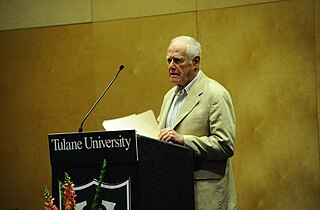A first-person narrative is a mode of storytelling in which a narrator relays events from their own point of view using the first person i.e. "I" or "we", etc. It may be narrated by a first person protagonist, first person re-teller, first person witness, or first person peripheral. A classic example of a first person protagonist narrator is Charlotte Brontë's Jane Eyre (1847), in which the title character is also the narrator telling her own story, "I could not unlove him now, merely because I found that he had ceased to notice me".

Thomas Coraghessan Boyle, also known as T. C. Boyle and T. Coraghessan Boyle, is an American novelist and short story writer. Since the mid-1970s, he has published sixteen novels and more than 100 short stories. He won the PEN/Faulkner award in 1988, for his third novel, World's End, which recounts 300 years in upstate New York.

Xuefei Jin is a Chinese-American poet and novelist using the pen name Ha Jin (哈金). Ha comes from his favorite city, Harbin. His poetry is associated with the Misty Poetry movement.

The Sound and the Fury is a novel written by the American author William Faulkner. It employs a number of narrative styles, including stream of consciousness. Published in 1929, The Sound and the Fury was Faulkner's fourth novel, and was not immediately successful. In 1931, however, when Faulkner's sixth novel, Sanctuary, was published—a sensationalist story, which Faulkner later claimed was written only for money—The Sound and the Fury also became commercially successful, and Faulkner began to receive critical attention.

James Arnold Horowitz, better known as James Salter, his pen name and later-adopted legal name, was an American novelist and short-story writer. Originally a career officer and pilot in the United States Air Force, he resigned from the military in 1957 following the successful publication of his first novel, The Hunters.

Ellery Queen's Mystery Magazine is an American digest size fiction magazine specializing in crime fiction, particularly detective fiction, and mystery fiction. Launched in fall 1941 by Mercury Press, EQMM is named after the fictitious author Ellery Queen, who wrote novels and short stories about a fictional detective named Ellery Queen. From 1993, EQMM changed its cover title to be Ellery Queen Mystery Magazine, but the table of contents still retains the full name.

Intruder in the Dust is a novel by the Nobel Prize–winning American author William Faulkner published
in 1948.
Edward Paul Jones is an American novelist and short story writer. His 2003 novel The Known World received the Pulitzer Prize for Fiction and the International IMPAC Dublin Literary Award.
Ikkemotubbe is a fictional Chickasaw Indian chief living in Yoknapatawpha County, Mississippi. He appears in novels and short stories of William Faulkner, such as in the collection of stories titled III The Wilderness: "Red Leaves," "A Justice," and "A Courtship". He is referenced extensively in Faulkner's popular classic 'The Bear" as the original owner of the land that was sold to Carothers McCaslin, the first white landowner of the woods in which the story takes place. After a steamboat trip to New Orleans, his name is "Frenchified" to "L'Homme" or "De l'Homme", which he himself later re-Anglicizes to "Doom."
Walter Abish is an Austrian-American author of experimental novels and short stories. He was awarded an MacArthur Fellowship in 1987.
"Dry September" is a short story by William Faulkner. Published in 1931, it describes a lynch mob forming on a hot September evening to avenge an alleged insult or attack upon a white woman by a black watchman, Will Mayes. Told in five parts, the story includes the perspective of the rumored female victim, Miss Minnie Cooper, and of the mob's leader, John McLendon. It is one of Faulkner's shorter stories.
"Shingles for the Lord" is a short story written by the American author William Faulkner, first published in The Saturday Evening Post in 1943. The story takes place in Faulkner's Yoknapatawpha County focusing on Res Grier, a struggling farmer, as he joins his neighbors in roofing the old church house and is narrated by his son in colloquial language. The story is on the surface a comic diversion, developing a plot similar to that of a situation comedy in which the attempt of one character to outsmart the others leads him to a sort of banishment or ostracism from which he must recuperate himself in order to reclaim his place in the community.
"Landing in Luck" was William Faulkner's first published short story. Appearing in the November 26, 1919 issue of The Mississippian, a literary magazine at the University of Mississippi, "Landing in Luck" tells the story of Cadet Thompson, who is sent on a solo flight without adequate instruction. Thompson lands successfully, and his flight instructor, Bessing, takes credit for the fine job he did of teaching the cadet pilot. It is a fictional exaggeration based on Faulkner's experience as a cadet-pilot for the Royal Air Force (RAF) in 1918.
"Spotted Horses" is a novella written by William Faulkner and originally published in Scribner's magazine in 1931. It includes the character Flem Snopes, who appears in much of Faulkner's work, and tells in ambiguous terms of his backhand profiteering with an honest Texan selling untamed ponies. Spotted Horses was later incorporated into The Hamlet under the title "The Peasants: Chapter One".
It features V.K Ratliff who appears in other Faulkner short stories and is a prominent character in The Hamlet, The Town and The Mansion.

The bibliography of William Faulkner, an American writer, includes 19 novels, 125 short stories, 20 screenplays, one play, six collections of poetry as well as assorted letters and essays.
Whit Burnett was an American writer and writing teacher who founded and edited the literary magazine Story. In the 1940s, Story was an important magazine in that it published the first or early works of many writers who went on to become major authors. Not only did Burnett prove to be a valuable literary birddog for new talent, but Story remained a respectable though low-paying alternative for stories rejected by the large-circulation slick magazines published on glossy paper like Collier's or The Saturday Evening Post or the somewhat more prestigious and literary slick magazines such as The New Yorker. While Story paid poorly compared to the slicks and even the pulps and successor digest-sized magazines of its day, it paid better than most of, and had similar cachet to, the university-based and the other independent "little magazines" of its era.
Knight’s Gambit is a 1949 short story collection by the American author William Faulkner, and contains a short story of the same name. The book collects six of Faulkner’s stories about attorney Gavin Stevens, who also takes a leading part in his novel Intruder in the Dust.









